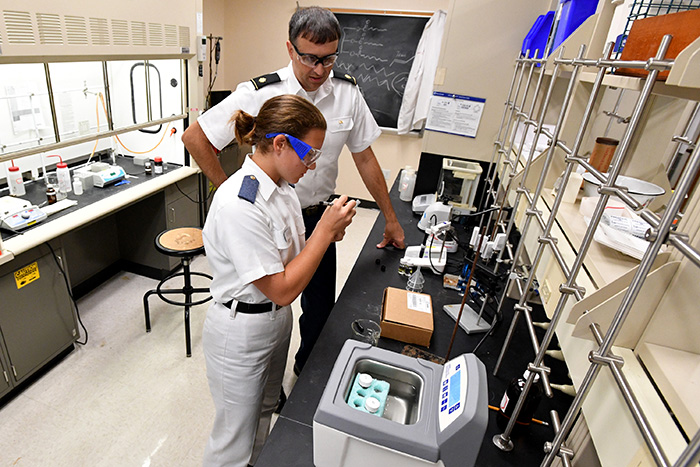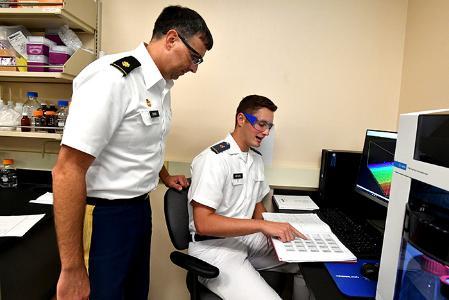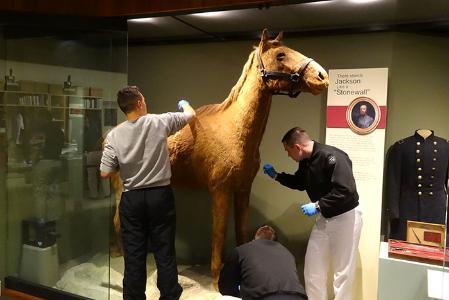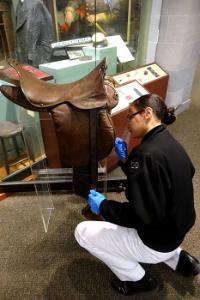From Incan Pots to Forged Checks

Maj. Kevin Braun watches as Noelle Heilpern ’23 prepares a pottery sherd for analysis. - VMI Photo by Kelly Nye
Chemistry Professor Searches for Clues to Life’s Mysteries
By Mary Price
“Chemistry can answer a lot of questions.”
So says Maj. Kevin Braun, who was still in college when he discovered that a career in chemistry could allow him to deepen his interests in archaeology, anthropology, and forensics.
Now in his second year of teaching at VMI, Braun, assistant professor of chemistry, is still mixing and melding those interests as he invites cadets to share in his research, most of which centers around chemical archaeology and forensic chemistry.
One such cadet—Noelle Heilpern ’23—is only in her rat year, yet she’s working on an analysis of lipid (fat and oil) residues found within archaeological pottery samples from a settlement of the Arikara, a Native American tribe that made its home in the Dakotas. Members of the tribe cultivated the “three sisters” crops of corn, squash, and beans, and supplemented their diets with meat from bison and other animals.
Analysis of the pots the Arikara used to cook food, Braun explained, could provide clues to learning more about their diet and how they lived—and unglazed pottery often holds residues of the fats and oils from foods the pottery once contained. The sherds, or fragments, of such pottery, now line a shelf of Braun’s lab, each placed in a numbered plastic bag.
“I’m doing lipid analysis on these pottery sherds to determine what kind of materials and food products were used in [them], to see what the indigenous peoples were going to be using the pottery for, to determine what kind of fatty acids and other lipids are detected in the pottery,” said Heilpern.
Braun explained that beginning in the late 18th century, the Arikara were forced to move north into what is now North Dakota—a region with a much shorter growing season than their native South Dakota.
“The archaeologist on this project is really interested in figuring out how [the Arikara] adapted to being in a new environment,” said Braun. “It’s not clear how they adapted to being in that climate zone, so hopefully the residue analysis will be able to kind of help put some pieces together.”
The ultimate goal of the work, Braun commented, is to determine if contact with Europeans, such as Spanish traders traveling up the Missouri River, decreased the dietary diversity of the Arikara.
Heilpern noted that she’s grateful to have a chance to do independent research very early in her college career.
 “I like the chemical methodology behind it,” said Heilpern. “I like learning new techniques. As a rat, I’m not very well-versed in chemistry yet, so being able to try out all of these different techniques and tools, it kind of puts me ahead of the curve.”
“I like the chemical methodology behind it,” said Heilpern. “I like learning new techniques. As a rat, I’m not very well-versed in chemistry yet, so being able to try out all of these different techniques and tools, it kind of puts me ahead of the curve.”
Braun added that he’s applied for a National Geographic Society grant that, if awarded to him, would be used to fund a trip to Peru, where he and cadets could analyze pre-Incan pots found in the Peruvian High Andes.
Also working in Braun’s lab this fall is Tom Wiltshire ’22, who is analyzing pen inks to detect possible forgeries. “My research is using a method called capillary electrophoresis to identify different types of pen inks,” said Wiltshire.
Capillary electrophoresis, explained Braun, is a way of separating molecules based on their interaction with an electrical field.
Among the many applications of this technology is the detection of forged or altered checks. Currency, said Braun, is now much harder to forge than it once was, but checks are still vulnerable to fraud.
“A lot of what we’re looking at is when someone has written a check, and then someone goes back and modifies the check,” Braun commented. “What would be a $1,000 check becomes a $9,000 check.”
For now, Braun and Wiltshire are dealing with fresh inks, but they have plans to change that strategy down the road.
“My future research is going to deal with ink degradation over time,” said Wiltshire. “A lot of past research has included perfect samples that are created in the lab. I want to test what happens if it’s exposed to sunlight or water, what happens if you carry a check around in your pocket.”
Another upcoming change has to do with including the analysis of printer inks. “Right now it’s only pen inks,” Wiltshire commented. “I’d like to transfer it to printer inks because a lot of times now we have really high-tech printers that can take high-tech pictures of bus tickets and game tickets, and they can be used as fakes.”
Wiltshire began working in Braun’s lab at the end of his 4th Class year. “From the start, I was captivated,” he said. “You see it on TV—all of these crime shows. It’s so popular on Netflix.” He added that his research gives him a lot to talk about with his mother, who works for the Department of the Treasury.
“I’m so privileged, as only a sophomore in college, to be doing such high-level research,” said Wiltshire. “It’s really giving me insight into what graduate school might be like, and possibly careers in the field of chemistry.”
Chemistry Cadets Test for Arsenic at VMI Museum
Who would have thought that a long-dead horse, plus his saddle and riding blanket, might contain a highly toxic element?
It sounds unreal, but it’s true: thanks to the past usage of arsenic as a preservative on both taxidermy specimens and organic materials kept in museums, some museum exhibits can have dangerous levels of the element. While there is no danger to museum visitors, thanks to glass cases enclosing the specimens, museum workers need to know which items should be handled with special precautions.
That’s why Maj. Kevin Braun, assistant professor of chemistry, and the cadets in his chemical archaeology class have come to the VMI Museum—to measure arsenic levels in the hide of Gen. Thomas J. “Stonewall” Jackson’s horse, Little Sorrel, which has been preserved and mounted on a wooden form. Also tested were the saddle and riding blanket that Jackson used on the animal.
“The art of preservation requires you to prevent things from growing or chewing on your artifacts,” explained Braun, an archaeological chemist who is now in his second year of teaching at VMI. Braun noted that up until the 1980s, taxidermists routinely used arsenic to preserve specimens. Likewise, it was once common practice for museum curators to spray or paint any organic items such as leather and cloth with arsenic, mercury, and even strychnine to keep rodents and insects from damaging them.
“Arsenic, over time, can become transferable, and that’s where the real danger is,” said Braun. He explained that when specimens are not kept in a climate-controlled environment, as was the case before museums began employing modern technology to control humidity, the arsenic inside the specimens can migrate to the surface and potentially cause health problems for museum employees.
It’s a problem that no one was aware of until 1990 when Congress passed the Native American Graves Protection and Repatriation Act (NAGPRA), which stated that museums must return certain Native American artifacts to the indigenous peoples from which they came. When museums complied with the act, Braun noted, the people who worked with the items began getting sick.
“NAGPRA was a huge, huge wake-up call for museums,” said Braun.
When he arrived at VMI last fall, Braun got in touch with Col. Keith Gibson ’77, director of the VMI Museum System, seeking permission to test Little Sorrel and the riding gear associated with the animal. With Gibson’s blessing, Braun and several cadets visited the museum in the fall of 2018 to test for arsenic.
 They didn’t find arsenic on the horse, but Braun thinks that is likely the result of Little Sorrel having recently had a bath, courtesy of workers from the Smithsonian Institution, who took the specimen outside and washed it.
They didn’t find arsenic on the horse, but Braun thinks that is likely the result of Little Sorrel having recently had a bath, courtesy of workers from the Smithsonian Institution, who took the specimen outside and washed it.
“That doesn’t mean [the arsenic’s] not there,” said Braun. “It just means it’s below detection limits.”
The cadets did, though, find arsenic on the saddle and riding blanket. As of early October, Braun was planning a second museum visit for later in the month, during which he and the cadets would conduct more extensive testing of those items.
The goal, he explained, would be to test for arsenic on both sides of the items. If levels on the side exposed to the horse are higher, that would suggest the arsenic migrated up from the animal onto the saddle and riding blanket. If the levels are high all over, it is more likely that the items had arsenic applied to them as a preservative.
For Braun, the museum field trip is a way to get cadets involved in hands-on projects using chemical analysis.
“One of my projects has been to make labs more engaging by taking current research topics and putting them into undergraduate research laboratories,” he stated.
.svg)
.png)